Physical Address
304 North Cardinal St.
Dorchester Center, MA 02124
Pituitary tumors present in various ways as a result of excess or deficient secretion of pituitary hormones or extrinsic compression on the pituitary stalk or adjacent structures. Approximately 75% of pituitary adenomas are functioning tumors; of these, half are prolactinomas, less than 25% secrete growth hormone, and the rest secrete adrenocorticotropic hormone, follicle-stimulating hormone, luteinizing hormone, or thyroid-stimulating hormone.
Functioning tumors often present with symptoms due to hormone hypersecretion, and nonfunctioning tumors generally present with symptoms due to mass effect.
Transsphenoidal adenomectomy is the first line of treatment for nonfunctioning tumors. Medical therapy is the first line of treatment for prolactinomas. Other functioning adenomas generally require surgical resection, medical treatment, or radiation therapy. Surgery through the microscopic, extended transsphenoidal, or endoscopic transphenoidal route is safe and effective in experienced hands. Craniotomy may be required for a tumor extending beyond the sellar region.
Patients with functioning pituitary adenomas require long-term follow-up to assess clinical and laboratory parameters. This is best done at a center that can provide a neurosurgeon, an endocrinologist, a radiation oncologist, and a neuro-ophthalmologist. Pituitary hormones should be regularly followed in all these patients; patients with residual tumor after treatment should be monitored with magnetic resonance imaging scans, and patients with optic nerve compression require periodic formal visual field testing.
The pituitary gland regulates the function of numerous other glands, including the thyroid, adrenals, ovaries, and testes. It controls linear growth, lactation, and uterine contractions in labor, and it manages osmolality and intravascular fluid volume via resorption of water in the kidneys. It secretes eight peptide hormones, six from the anterior lobe and two from the posterior lobe ( Table 44.1 ).
| Hypothalamus | Pituitary | End Organ | |||
|---|---|---|---|---|---|
| Pituitary Cell | Pituitary Hormone | Organ | Hormone | Primary Functions | |
| Anterior Lobe | |||||
| Releasing Factors | |||||
| Corticotropin-releasing hormone (CRH) | Corticotroph | Adrenocorticotropic hormone (ACTH)—adrenocorticotropin, corticotropin | Adrenals | Cortisol | General metabolism; required for physiologic adaptation to stress |
| Thyrotropin-releasing hormone | Thyrotroph | Thyroid-stimulating hormone (TSH) | Thyroid | Thyroid hormones—T 3 , T 4 | General metabolism; influences pace of metabolism |
| Gonadotropin-releasing hormone (GnRH) | Gonadotroph | Follicle-stimulating hormone (FSH) | Ovaries | Estradiol, progesterone | Required for normal female sexual development and fertility |
| Luteinizing hormone (LH) | Testes | Testosterone | Required for normal male sexual development and fertility | ||
| Growth hormone–releasing hormone (GHRH) | Somatotroph | Growth hormone (GH)—somatotropin | Liver and other tissues | Somatomedin—insulin-like growth factor-I (IGF-I) | Growth, glucose regulation |
| Inhibiting Factors | |||||
| Dopamine—PIF | Lactotroph | Prolactin (PRL) | Breast, gonads | Prolactin | Lactation |
| Somatostatin | Somatotroph | Growth hormone (GH) | Liver and other tissues | Somatomedin—IGF-I | Growth, glucose regulation |
| Posterior Lobe | |||||
| Antidiuretic hormone (ADH)—vasopressin | ADH produced in hypothalamus stored in posterior pituitary | Kidney | ADH | Resorption of water in the kidney | |
| Oxytocin | Oxytocin produced in hypothalamus; stored in posterior pituitary | Uterus | Oxytocin | Uterine contractions during labor | |
The pituitary gland lies in the sella turcica, a saddle-shaped concavity in the sphenoid bone. Its stalk, which contains the pituitary portal veins and neuronal processes, passes through the diaphragma sella (a layer of arachnoid), just above which pass the optic nerves ( Fig. 44.1 ). The cavernous venous sinuses form the lateral borders of the sella and contain within them the internal carotid arteries; cranial nerves III, IV, and VI; and the ophthalmic and maxillary divisions of cranial nerve V.
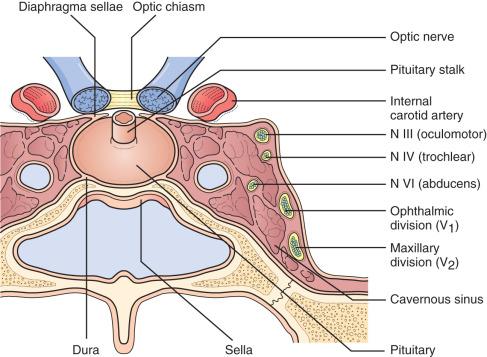
In the anterior lobe of the pituitary gland, known as the adenohypophysis, five distinct types of cells produce and secrete six different hormones. Lactotroph cells make prolactin (PRL), somatotroph cells produce growth hormone (GH), corticotrophs secrete adrenocorticotropic hormone (ACTH), thyrotrophs make thyroid-stimulating hormone (TSH), and gonadotrophs produce follicle-stimulating hormone (FSH) and luteinizing hormone (LH). The secretion of these hormones is regulated by the hypothalamus and by inhibitory feedback control by target organ hormone products ( Figs. 44.2 and 44.3 ).
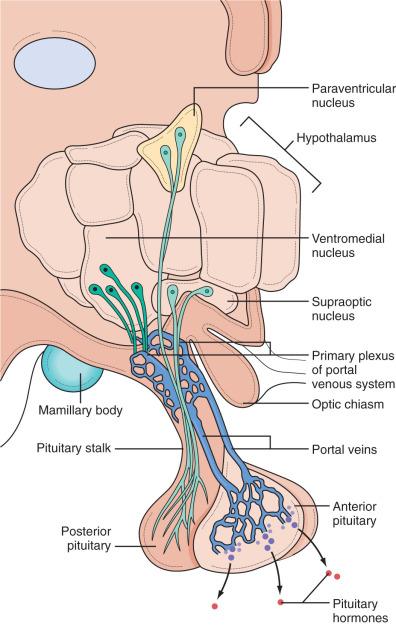
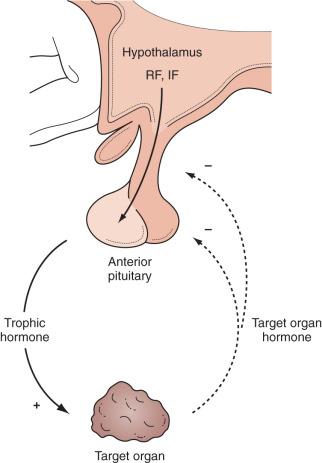
The posterior lobe of the pituitary, the neurohypophysis , secretes antidiuretic hormone (ADH) and oxytocin, which are produced by hypothalamic neurons and released directly from nerve terminals in the posterior pituitary.
The hypothalamus secretes releasing factors to stimulate the production of pituitary hormones. Corticotropin-releasing factor (CRH), thyrotropin-releasing factor (TRH), and gonadotropin-releasing hormone (GnRH) positively regulate the production of ACTH, TSH, and the gonadotropins, LH and FSH. GH secretion is more complicated in that it receives both positive and negative hypothalamic manipulation, via GH-releasing hormone (GHRH) and somatostatin, respectively. Prolactin secretion is primarily inhibited by the hypothalamic release of dopamine, also known as prolactin-inhibiting factor. Some of these hypothalamic factors influence the production of more than one anterior pituitary hormone. For instance, TRH, which primarily stimulates TSH production, also has a positive effect on prolactin release.
Pituitary adenomas are composed of adenohypophyseal cells, which constitute 10% to 15% of primary intracranial tumors. Among pituitary tumors, the majority are functioning, or hormone-secreting, tumors, whereas approximately 30% are classified as nonfunctioning adenomas.
Symptoms and signs of disorders affecting the pituitary reflect the function and anatomy of the gland. Because of its diverse array of functions as well as the multiple structures in close proximity to the gland, pituitary tumors present in various ways due to excess or deficient secretion of pituitary hormones or extrinsic compression on the pituitary stalk or adjacent structures.
Pituitary adenomas have an annual incidence of 25 per 1 million people and account for nearly 10% of all surgically resected brain tumors, with nonfunctioning adenomas and prolactinomas being the most common pituitary tumors. Many of these tumors are subclinical and may never present during a patient's lifetime; autopsy studies show an 11% to 27% incidence of occult microadenomas. Pituitary tumors are the third most common primary intracranial neoplasm, behind glioma and meningioma, and are more common among African Americans, in whom they account for more than 20% of central nervous system neoplasms.
Microadenomas are most often found in women of childbearing age. Though studies in the 1970s appeared to demonstrate a higher incidence of adenomas among women than men, it is unclear if there is a higher prevalence among women or if the effect of a tumor on pituitary function, and therefore reproduction, leads to a higher rate of detection. Autopsy studies show no sex predominance. Men with pituitary tumors more often present with macroadenomas in their fifth and sixth decades of life.
The major classifications of pituitary tumors are based on their size, secretory abilities, and histologic type. Tumors with a diameter of less than 10 mm are microadenomas, and those greater than 10 mm are macroadenomas. Tumors greater than 4 cm are considered giant adenomas.
Functioning adenomas are generally classified by the hormones they secrete. Any of the multiple cell types within the pituitary can lead to a functioning pituitary tumor. Functioning tumors may secrete PRL, GH, ACTH, FSH, LH, or TSH. Nonfunctioning tumors do not secrete clinically relevant levels of hormone. However, even among nonfunctioning tumors, multiple different tumor types are found, including null cell, oncocytoma, silent gonadotropin or glycopeptide-secreting, silent corticotropin-secreting, and silent somatotropin-secreting.
According to the World Health Organization (WHO), tumors with benign histologic features are typical pituitary adenomas, but rare invasive tumors with an increased rate of mitosis and extensive p53 nuclear reactivity are classified as atypical adenomas. Pituitary carcinoma is very rare, constituting less than 0.2% of pituitary tumors, and the diagnosis is made only when distant metastases are found.
Nonfunctioning adenomas account for 30% of pituitary tumors. The term nonfunctioning reflects the fact that these tumors do not cause clinical hormone hypersecretion and so do not cause hypersecretory syndromes. These tumors are heterogeneous with multiple histopathologic cell types. Though they do not cause signs of clinical hormone hypersecretion, histopathologic evidence of hormone expression is evident in more than 40%.
Pathologic specimens of null cell adenomas do not express hormones, but oncocytomas may show focal immunostaining for anterior pituitary hormones and produce hormones in vitro. Silent gonadotropes morphologically resemble glycopeptide-secreting tumors and stain positive for FSH, LH, or the common α-subunit. Silent somatotropes stain positive for GH and silent corticotrophs stain positive for ACTH on pathologic specimen, but these tumors do not cause the clinical manifestations of acromegaly or hypercortisolemia, respectively.
Nonfunctioning adenomas are benign lesions that are typically large upon presentation and manifest with symptoms of mass effect. Pressure on the pituitary gland can lead to decreased pituitary function, and nearly one-third of these patients have hypopituitarism. Gonadotropins (LH and FSH) are generally the first hormones affected, then GH, followed by TSH and ACTH. Hormone dysfunction may lead to amenorrhea or hypogonadism and decreased libido, or to hypothyroidism with weight gain, depression, fatigue, and mental slowing. These changes develop insidiously as the tumor grows, so the patient may be unaware until the lesion is large.
Parasellar neurovascular structures may also be compressed. Superior enlargement effaces the optic chiasm, causing visual loss. Compression on the inferonasal fibers that decussate at the anterior and inferior aspect of the chiasm leads to superior temporal quadrantanopia, then bitemporal hemianopia. An adenoma may grow laterally into the cavernous sinus, leading to extraocular muscle palsies along cranial nerve III, IV, or VI that result in mydriasis, ptosis, facial pain, or, infrequently, diplopia or deficits to the sympathetic nerves causing miosis. Lateral invasion into the cavernous sinus is graded using the Knosp grading scale ( Fig. 44.4 ), which evaluates degree of tumor encasement around the cavernous carotid artery. Headache due to pressure on the dura may occur as well. Once a large tumor has extended out of the sella, it can cause pressure on the temporal or frontal lobes and, rarely, hydrocephalus via obstruction of cerebrospinal fluid (CSF) pathways. Occasionally, large adenomas become suddenly apparent after hemorrhage or infarction known as pituitary apoplexy. Pituitary lesions may be discovered incidentally during evaluations for other conditions such as trauma.
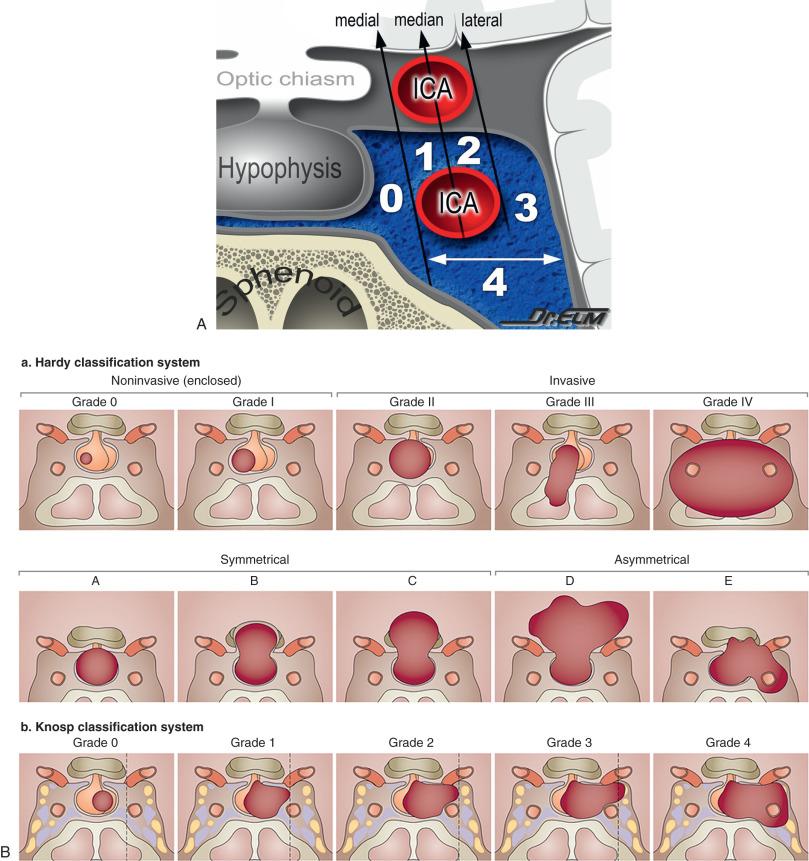
Patients with a pituitary mass should undergo a complete neurologic and endocrinologic evaluation including a detailed history and physical examination to assess for signs or symptoms of hypersecretory syndromes such as Cushing disease, hyperprolactinemia, or acromegaly. Endocrinologic testing is needed to determine hormonal function. Laboratory studies include prolactin, FSH, LH, GH, insulin-like growth factor 1 (IGF-1), ACTH, cortisol, TSH, thyroxine, estradiol, and testosterone. A mildly elevated prolactin level does not exclude a nonfunctioning tumor, as any sellar mass can compress the stalk, interrupting dopaminergic inhibition of PRL and leading to mild hyperprolactinemia up to 150 µg/mL known as the stalk effect. Neuro-ophthalmologic examination, including visual field testing and visual acuity, is necessary before and after treatment to document deficits and monitor changes.
Plain radiographs may demonstrate an enlarged, round sella, and the sellar floor may appear doubled due to a thinned, asymmetrically worn lamina dura. High-resolution magnetic resonance imaging (MRI) with cuts through the sellar region is essential for surgical planning, as it will show the precise size and location of the lesion as well as its relationship with the chiasm, cavernous sinus, and other surrounding structures ( Fig. 44.5 ), and a computed tomography (CT) scan will demonstrate the sphenoid sinus anatomy.
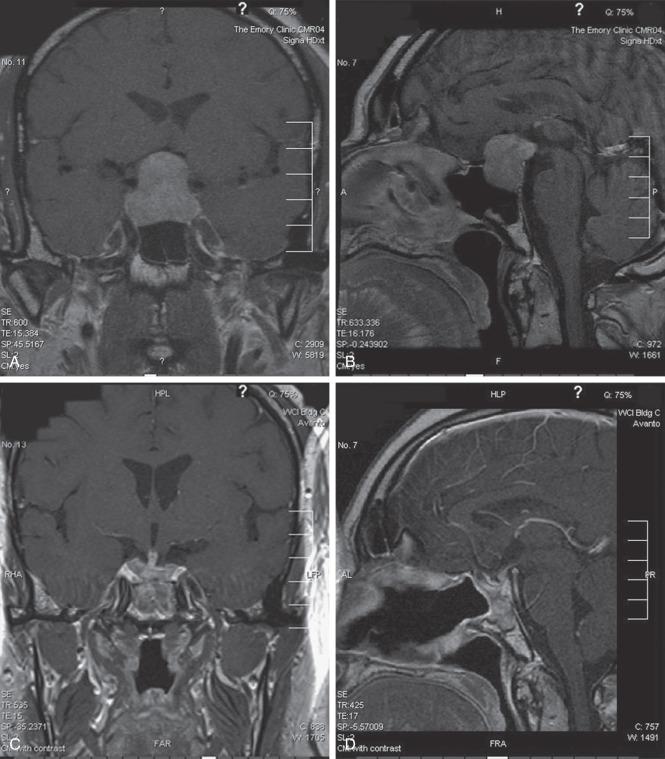
The differential diagnosis of a nonfunctioning pituitary adenoma includes multiple other lesions, such as functioning pituitary tumors, which can be differentiated by laboratory results. A Rathke cleft cyst may appear similar to a cystic pituitary adenoma. A tuberculum sellae meningioma may compress the chiasm, but it will generally not cause enlargement of the sella. A craniopharyngioma is more often a suprasellar lesion. Metastasis to the sella will often cause diabetes insipidus or extraocular muscle palsies, which are rarely seen in patients with pituitary adenomas. An internal carotid artery aneurysm may fill the sella; however, a flow void will be visible on MRI. A sarcoid granuloma or a tuberculoma is rare.
The first line of treatment for a nonfunctioning pituitary adenoma is endoscopic transsphenoidal resection of the tumor, which provides immediate relief of mass effect and has a low rate of complications. This surgery is generally done as an elective procedure. An extended transsphenoidal approach may be needed when the tumor has reached beyond the sella, and a transcranial approach or combined transsphenoidal-transcranial approach may be considered if there is significant supratentorial tumor extension.
The goals of surgery are to eliminate mass effect from the pituitary and surrounding structures, to preserve or restore pituitary and visual function, to resect enough of the lesion to prevent recurrence, and to obtain tissue for histopathologic analysis.
Hermann Schloffer performed the first transsphenoidal resection of a pituitary tumor in 1907, and Harvey Cushing popularized it in the two decades afterward. Neurosurgeons have been trying to perfect the transsphenoidal adenomectomy (TSA) ever since. The standard methods in use today involve either an endonasal or sublabial approach to the sella.
In the endonasal transsphenoidal approach, the patient's head is placed in a Mayfield cranial fixation clamp. The body is placed supine with the neck somewhat extended and the head turned slightly toward the right to face the surgeon, permitting a good view through the nares NOW ( Fig. 44.6 ).
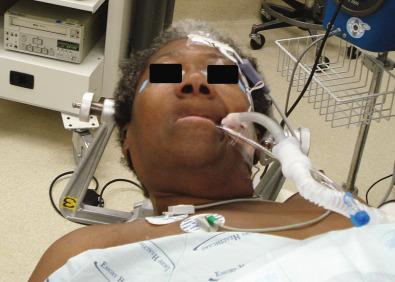
In a direct endonasal approach, the surgeon enters directly into the sphenoid sinus though the sphenoid ostium. In the microscopic unilateral transseptal approach, a small incision is made in the right nostril mucosa and a submucosal plane is developed along the septum until the anterior wall of the sphenoid sinus is identified. A speculum is inserted and the septum is subluxed and deviated.
The operating microscope is brought into the field and the sphenoid sinus is opened with an osteotome and Kerrison rongeur. The opening is enlarged to allow visualization of the lateral portion of the sella. Some surgeons then obtain fluoroscopic or image-guided confirmation of the sella's position; however, direct visualization is generally sufficient.
An osteotome and up-biting Kerrison rongeur are used to open the sellar floor. The dura is revealed, and a midline vertical incision is made with a No. 11 blade. Up-angled scissors are used to enlarge the dural opening and expose the adenoma. The tumor may be debulked intracapsularly, or an extracapsular plane may be developed along the tumor's pseudocapsule. The tumor is extracted piecemeal using ring curets, pituitary rongeurs, gentle suction, and irrigation. Adenoma removal can involve significant bleeding, making adequate suction imperative, as the bleeding often ceases only when the tumor is removed.
After tumor resection, the sellar floor may be repaired with DuraForm, fascia, fat from the patient's abdomen, bone, cartilage, or prosthesis. The sphenoid sinus may be packed with DuraForm, DuraSeal, or fat. The speculum is removed, the septum returned to midline, and the mucosa is sutured shut at the inside edge of the naris with absorbable suture. The patient will have copious mucosal secretions postoperatively, so a nasal trumpet may be placed in the nares overnight.
If a spinal fluid leak occurs through the diaphragm sella, then a sealant such as DuraSeal or Tisseel can be used to seal the leak and reconstruct the floor of the sella with bone, cartilage, or prosthesis, with or without a free-fat graft from the abdomen. A few days of lumbar drainage of CSF may be used as well.
The endoscope may be used in place of the microscope. When performing an endoscopic TSA, the patient is positioned in a manner similar to that used for the standard microscopic approach. A 4-mm or 2.7-mm endoscope is used to visualize the sphenoethmoid recess. The bilateral sphenoid ostia are entered and widened using a mushroom punch. The posterior nasal septum is incised and resected using a microdebrider and straight through-cutting instruments. The anterior wall of the sphenoid sinus is resected using straight through-cutting instruments and Kerrison punches.
The lesion is removed in the same manner as with the microscopic approach. The endoscope provides a wide field of view, and angled scopes permit enhanced inspection of the walls of the sella, as well as the suprasellar, retrosellar, and parasellar regions to search for residual tumor. Three-dimensional endoscopes permit stereoscopic vision, depth perception, and a more realistic, nondistorted view of the regional anatomy than do the conventional two-dimensional endoscopes ( Fig. 44.7 ).
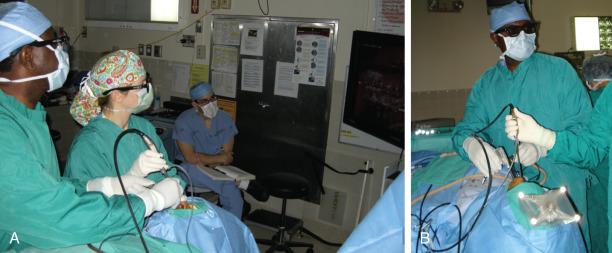
After the lesion is removed, DuraForm is placed over the sella. Gelfoam is used to pack the sphenoid sinus, and NasoPore is laid over the bilateral sphenoethmoid recesses. If a CSF leak is present, a mucosal septal flap may be used to assist in closure. A speculum is not needed with this approach.
Pediatric patients with small nares or patients with large tumors may be treated via a sublabial TSA. The patient's upper lip is retracted and a horizontal incision is made in the gingival mucosa. A pathway is followed to the maxilla and floor of the nasal cavity. A vertical incision is made, separating the nasal mucosa from the septum. The anterior septum is subluxed, the speculum is inserted, and the operating microscope or endoscope is brought into the field. The operation continues in a similar fashion to the endonasal approach just described.
A TSA may be performed with frameless stereotactic neuronavigation to assist with large lesions that involve the carotid arteries or recurrent lesions where a prior operation has altered the normal anatomy. The operation is performed as just described; however, the surgeon is able to check his or her position at any point during the procedure to assess the proximity of surrounding structures or determine when he or she is approaching the limits of the tumor NOW ( Fig. 44.8 ).
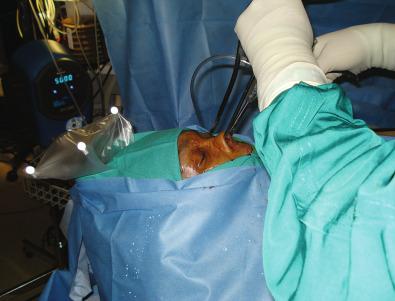
Following operative decompression, vision generally improves and endocrine function recovers to a lesser extent, and surgical resection generally halts progressive loss of hormonal function. After TSA, visual field defects will improve in 70% to 89% of patients, will not change significantly in 7%, and will worsen in less than 4% of patients.
Approximately 30% of patients with nonfunctioning adenomas have some degree of hypopituitarism prior to surgery. In one-quarter of these patients, preoperative pituitary deficiencies will improve after surgery, although 10% of patients have some postoperative worsening of hormone function. Oral hormone replacement is generally sufficient for patients whose pituitary deficiencies worsen or do not improve.
Complications from transsphenoidal surgery include intracranial hemorrhage, carotid artery injury, ischemic stroke, visual impairment, CSF leak, nasal septal perforation, and epistaxis. The risk of stroke or death is less than 1%, the risk of visual loss is less than 2%, and the risk of CSF rhinorrhea is less than 4%.
After transsphenoidal removal of an adenoma, hormone levels must be closely followed because the patient is at risk for hypopituitarism. Morning cortisol levels are checked for several days, and patients with hypocortisolemia are treated with steroid replacement as needed.
Diabetes insipidus (DI) and the syndrome of inappropriate antidiuretic hormone secretion (SIADH) are common but transient postoperative complications after transsphenoidal surgery. Nearly 18% of patients develop DI, though this is often temporary. It is imperative to closely monitor fluid balance, serum sodium levels, and urine specific gravity. In a small number of patients, hyponatremia can occur a week or more after the surgery.
The classic “triphasic” response after a TSA is a fluctuation of sodium levels in the postoperative period. There is an initial period of DI and hypernatremia for 4 to 5 days immediately post-op (phase 1) due to reduction of ADH release from hypothalamic and posterior pituitary dysfunction. This is followed by a release of ADH as the posterior pituitary degenerates that results in 4 to 5 days of sodium normalization or even hyponatremia/SIADH (phase 2). The last phase is transient or permanent DI (phase 3) due to depletion of ADH stores.
Following resection of a giant macroadenoma, when it is likely that some residual tumor may remain, a rare but potentially fatal complication is postoperative apoplexy. This complication must be closely monitored for. In one study of 134 surgically resected giant adenomas, four patients had fatal postoperative pituitary apoplexy.
The mortality rate for patients undergoing transsphenoidal surgery is very low, approximately 0.5%. Among giant macroadenomas, the mortality rate is approximately 1%. After successful surgical resection, 10% to 20% of tumors are reported to recur within 6 years. At 10-year follow-up, more than 80% of patients who underwent transsphenoidal resection of a nonfunctioning pituitary adenoma are alive and disease free.
Medical therapy is available for functioning tumors, but there are no available effective drug regimens for nonfunctioning pituitary adenomas. Multiple medical therapies have been tested. Dopamine agonists lead to a small reduction in tumor size in less than 10% of patients, and octreotide has improved visual deficits among some patients with macroadenomas. However, most patients with nonfunctioning pituitary tumors will gain no clinical or biochemical benefit from medical therapies.
Radiation therapy may be used in patients with recurrent or residual tumor or in patients who cannot tolerate surgery. Radiotherapy controls tumor growth in 80% to 98% of nonfunctioning tumors.
Conventional radiotherapy calls for fractionated doses of 1.6 to 2 Gy four or five times per week for 5 to 6 weeks, for a maximum dose of 45 to 50 Gy. Tumors respond slowly, with benefits delayed for a year or more.
Stereotactic radiosurgery (SRS) uses only a single session to deliver focused radiation to the lesion with less radiation to surrounding structures. Several forms of SRS are available, including Gamma Knife surgery (GKS), linear accelerator (LINAC) radiation, and CyberKnife surgery. There is also fractionated stereotactic radiotherapy and proton beam therapy. SRS is generally able to use a higher radiation dose per fraction than is conventional radiation, and it usually results in earlier endocrine control. It is not risk free, however.
The major concern from SRS is radiation damage to the visual pathways, but this can be decreased by limiting the radiation dose to the optic chiasm to less than 10 Gy. Patients with adenomas closer than 2 to 5 mm to the optic chiasm or larger than 30 mm in diameter are generally not candidates for SRS, though they may undergo fractionated stereotactic radiotherapy or conventional radiation. The neuronal and vascular structures in the cavernous sinus are less radiosensitive, so an ablative dose may be administered to tumors with lateral invasion or impingement on the cranial nerves. This allows SRS to function as an adjuvant to surgical resection in patients with tumors that have invaded the cavernous sinus.
As with conventional radiotherapy, hormone deficiencies are the most common side effect with an incidence of 13% to 56%. The risks of radiation-induced second neoplasm and neuropsychiatric changes are lower with SRS than with conventional radiotherapy. Other side effects are rare. Long-term risk for radiation necrosis is approximately 0.2%. Optic neuropathy occurs in 1.7%, vascular changes in 6.3%, neuropsychological changes in 0.7%, and radiation-induced secondary malignancies in 0.8%. All forms of radiation therapy have delayed benefit, though SRS induces remission more rapidly than does fractionated radiotherapy.
Routine postoperative evaluation with MRI and CT should be delayed for at least 4 to 6 weeks after surgery because of the difficulty analyzing the tumor region in the setting of recent surgical changes. Mass effect seen in the early postoperative period usually resolves and can be followed with serial MRI.
Patients with nonfunctioning adenomas should undergo annual MRI or CT, as well as visual and endocrine evaluations, whether or not they have received treatment. If these tumors are not treated, they tend to grow slowly over months or years.
Because of the significant recurrence rate following transsphenoidal resection and the considerable number of patients who develop hypopituitarism after radiation therapy, the medical team should closely follow even successfully treated patients.
Become a Clinical Tree membership for Full access and enjoy Unlimited articles
If you are a member. Log in here